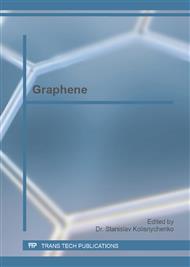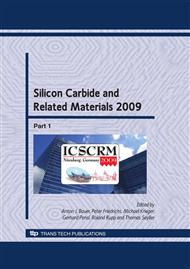[1]
K. S. Novoselov, A. K. Geim, S. V. Morozov, D. Jiang, Y. Zhang, S. V. Dubonos, I. V. Grigorieva, and A. A. Firsov: Science Vol. 306 (2004), p.666.
DOI: 10.1126/science.1102896
Google Scholar
[2]
A. K. Geim: Science Vol. 324 (2009), p.1530.
Google Scholar
[3]
International Technology Roadmap for Semiconductors (ITRS), http: /www. itrs. net.
Google Scholar
[4]
C. Berger, Z. M. Song, T. B. Li, X. B. Li, A. Y. Ogbazghi, R. Feng, Z. T. Dai, A. N. Marchenkov, E. H. Conrad, P. N. First, and W. A. de Heer: J. Phys. Chem. B Vol. 108 (2004), p.19912.
DOI: 10.1021/jp040650f
Google Scholar
[5]
T. Ohta, A. Bostwick, Th. Seyller, K. Horn, and E. Rotenberg: Science Vol. 313 (2006), p.951.
Google Scholar
[6]
A. Fissel: Phys. Rep. Vol. 379 (2003), p.149.
Google Scholar
[7]
J. Jobst, D. Waldmann, F. Speck, R. Hirner, D. K. Maude, Th. Seyller, and H. B. Weber: arXiv: 0908. 1900 [cond-mat. mes-hall].
Google Scholar
[8]
T. Shen, J. J. Gu, M. Xu, Y. Q. Wu, M. L. Bolen, M. A. Capano, L.W. Engel, and P.D. Ye: arXiv: 0908. 3822 [cond-mat. mes-hall].
Google Scholar
[9]
X. Wu, Y. Hu, M. Ruan, N. K. Madiomanana, J. Hankinson, M. Sprinkle, C. Berger, and W. A. de Heer: arXiv: 0908. 4112 [cond-mat. mes-hall].
Google Scholar
[10]
H. Hibino, H. Kageshima, F. Maeda, M. Nagase, Y. Kobayashi, and H. Yamaguchi: Phys. Rev. B Vol. 77 (2008), p.075413.
Google Scholar
[11]
H. Hibino, H. Kageshima, F. Maeda, M. Nagase, Y. Kobayashi, Y. Kobayashi, and H. Yamaguchi: e-J. Surf. Sci. Nanotechnol. Vol. 6 (2008), p.107.
DOI: 10.1380/ejssnt.2008.107
Google Scholar
[12]
H. Hibino, H. Kageshima, and M. Nagase: J. Phys. D, in press.
Google Scholar
[13]
M. Nagase, H. Hibino, H. Kageshima, and H. Yamaguchi: J. Phys. Conf. Ser. Vol. 100 (2008), p.052006.
Google Scholar
[14]
M. Nagase, H. Hibino, H. Kageshima, and H. Yamaguchi: Nanotechnol. Vol. 19 (2008), p.495701.
Google Scholar
[15]
H. Hibino, H. Kageshima, M. Kotsugi, F. Maeda, F. -Z. Guo, and Y. Watanabe: Phys. Rev. B Vol. 79 (2009), p.125437.
Google Scholar
[16]
M. Nagase, H. Hibino, H. Kageshima, and H. Yamaguchi: Nanotechnol. (2009), in press.
Google Scholar
[17]
H. Hibino, S. Mizuno, H. Kageshima, M. Nagase, and H. Yamaguchi: Phys. Rev. B Vol. 80 (2009), p.085406.
Google Scholar
[18]
H. Kageshima, H. Hibino, M. Nagase, and H. Yamaguchi: Appl. Phys. Exp. Vol. 2 (2009), p.065502.
Google Scholar
[19]
A. Mattausch and O. Pankratov: Phys. Rev. Lett. Vol. 99 (2007), p.076802.
Google Scholar
[20]
M. Fujita, K. Wakabayashi, K. Nakada, and K. Kusakabe: J. Phys. Soc. Jpn. Vol. 65 (1996), p. (1920).
Google Scholar
[21]
S. Okada, M. Igami, K. Nakada, and A. Oshiyama: Phys. Rev. B Vol. 62 (2000), p.9896.
Google Scholar



